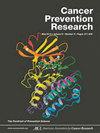Editors' Selections from Relevant Scientific Publications
IF 2.9
3区 医学
Q2 ONCOLOGY
引用次数: 0
Abstract
Highlights from the Literature| October 02 2023 Editors' Selections from Relevant Scientific Publications Author & Article Information Online ISSN: 1940-6215 Print ISSN: 1940-6207 ©2023 American Association for Cancer Research2023American Association for Cancer Research Cancer Prev Res (Phila) (2023) 16 (10): 539. https://doi.org/10.1158/1940-6207.CAPR-16-10-HFL Views Icon Views Article contents Figures & tables Video Audio Supplementary Data Peer Review Share Icon Share Facebook Twitter LinkedIn Email Tools Icon Tools Get Permissions Cite Icon Cite Search Site Article Versions Icon Versions Version of Record October 2 2023 Citation Editors' Selections from Relevant Scientific Publications. Cancer Prev Res (Phila) 1 October 2023; 16 (10): 539. https://doi.org/10.1158/1940-6207.CAPR-16-10-HFL Download citation file: Ris (Zotero) Reference Manager EasyBib Bookends Mendeley Papers EndNote RefWorks BibTex toolbar search Search Dropdown Menu toolbar search search input Search input auto suggest Search Advanced Search Breast cancer cells (by Annie Cavanagh via Flickr) Using phylogenetic of microdissected samples of cancer and non-cancer proliferative lesions, Nishimura et al. explored the genetic evolution of breast cancer, revealing a unique evolutionary pattern harboring der(1;16), a common driver alteration in 20% of all breast cancers and one-third of Luminal A breast cancers. In der(1;16)(+) cancers, the derivative chromosome was acquired from early puberty to late adolescence, followed by the emergence of a common ancestor by the patient's early 30s, leading to both cancerous and non-cancerous clones. These clones expanded significantly within the premenopausal breast before cancer diagnosis. Interestingly, multiple cancer clones originated from noncancer ancestors and there was no correlation between histology and the number of driver events, suggesting the involvement of epigenetic or microenvironmental factors in cancer development. These findings contribute to a better understanding of breast carcinogenesis and may improve early detection and prevention strategies. Nishimura... You do not currently have access to this content.编辑对相关科学出版物的选择
文献要义| 2023年10月2日编辑精选相关科学出版物作者与文章信息在线ISSN: 1940-6215印刷ISSN: 1940-6207©2023美国癌症研究协会2023美国癌症研究协会癌症预防研究(费城)(2023)16(10):539。https://doi.org/10.1158/1940-6207.CAPR-16-10-HFL查看图标查看文章内容图表和表格视频音频补充数据同行评审共享图标共享Facebook Twitter LinkedIn电子邮件工具图标工具获得权限引用图标引用搜索网站文章版本图标版本记录版本2023年10月2日引文编辑从相关科学出版物的选择。癌症预防中心(费城)2023年10月1日;16(10): 539。https://doi.org/10.1158/1940-6207.CAPR-16-10-HFL下载引文文件:Ris (Zotero)参考管理器EasyBib Bookends Mendeley论文EndNote RefWorks BibTex工具栏搜索搜索下拉菜单工具栏搜索搜索输入搜索输入自动建议搜索高级搜索乳腺癌细胞(by Annie Cavanagh via Flickr)利用癌症和非癌症增生病变的微解剖样本的系统发育,Nishimura等人探索了乳腺癌的遗传进化,揭示了一种独特的进化模式(1;16)。在20%的乳腺癌和三分之一的Luminal a型乳腺癌中,这是一种常见的驱动因素改变。在der(1;16)(+)癌症中,从青春期早期到青春期晚期获得衍生染色体,随后在患者30岁出头时出现共同祖先,导致癌性和非癌性克隆。这些克隆在癌症诊断前的绝经前乳腺癌中显著扩大。有趣的是,多个癌症克隆起源于非癌症祖先,组织学和驱动事件的数量之间没有相关性,这表明表观遗传或微环境因素参与了癌症的发展。这些发现有助于更好地了解乳腺癌的发生,并可能改善早期发现和预防策略。Nishimura……您目前没有访问此内容的权限。
本文章由计算机程序翻译,如有差异,请以英文原文为准。
求助全文
约1分钟内获得全文
求助全文
来源期刊

Cancer Prevention Research
医学-肿瘤学
CiteScore
6.00
自引率
3.00%
发文量
173
审稿时长
1 months
期刊介绍:
Cancer Prevention Research publishes original studies, reviews, and perspectives in the field of cancer prevention. Its scope includes the molecular and cellular biology of premalignancy and early lesions; genetic and environmental risk factors; risk assessment and reduction; early detection research (cancer screening and diagnosis); and preventive interventions (chemoprevention, immunoprevention, and others) to intercept cancer development at early stages prior to initiation, promotion, or progression. The journal comprises preclinical, clinical, and translational research, with special attention given to molecular discoveries and an emphasis on building a translational bridge between the basic and clinical sciences.
 求助内容:
求助内容: 应助结果提醒方式:
应助结果提醒方式:


